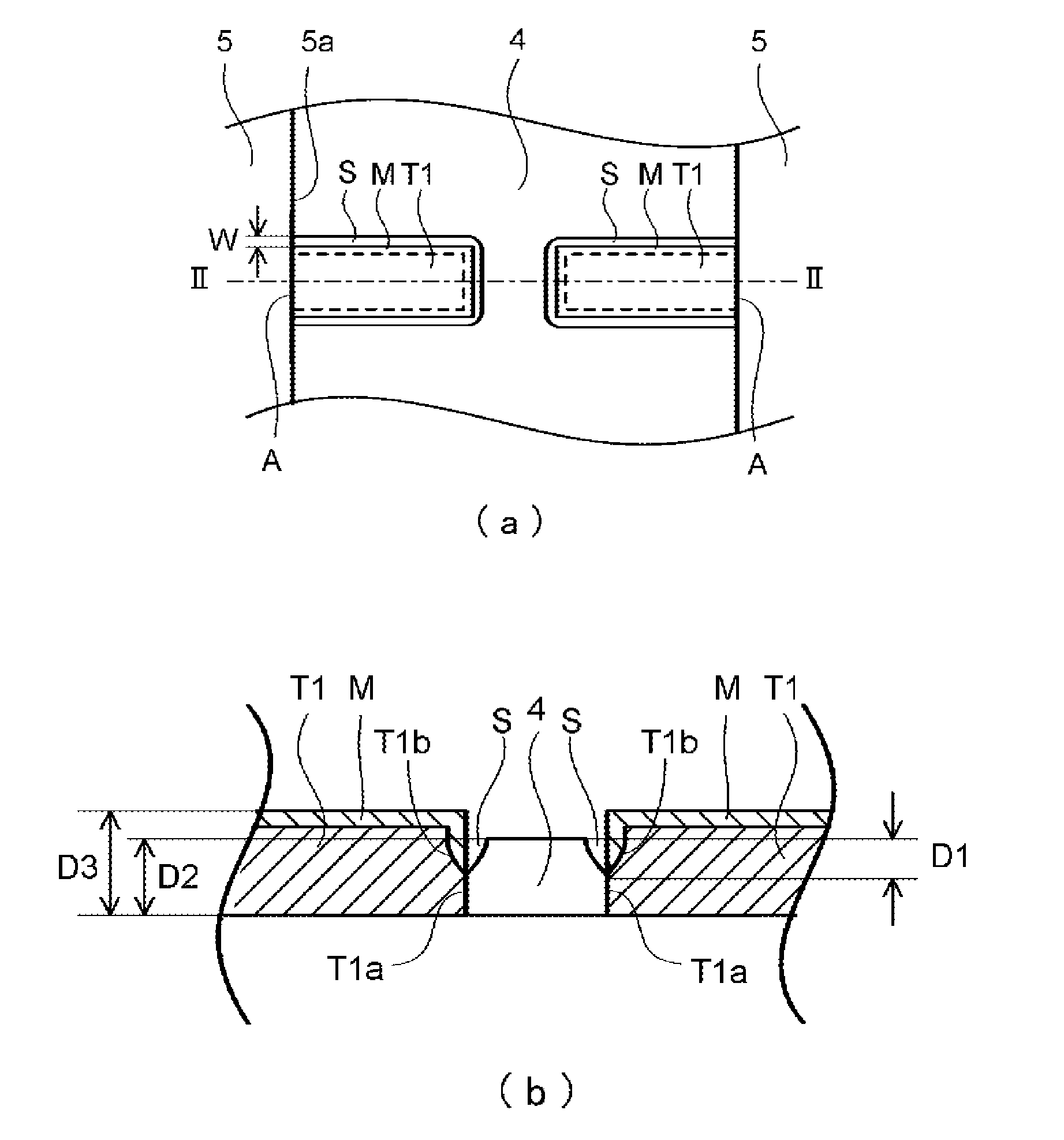Wiring board
a technology of wire board and wire, applied in the direction of resist details, printed circuit aspects, non-metallic protective coating applications, etc., can solve the problem of short circuit between these connection terminals, and achieve the effect of reducing the pitch
- Summary
- Abstract
- Description
- Claims
- Application Information
AI Technical Summary
Benefits of technology
Problems solved by technology
Method used
Image
Examples
first embodiment
[0042]FIG. 1 is a plan view (on the front surface side) of a wiring substrate 100 according to the first embodiment. FIG. 2 is a partially cross-sectional view of the wiring substrate 100 taken along line I-I of FIG. 1. FIG. 3 shows the configuration of connection terminals T1 formed on the front surface side of the wiring substrate 100. FIG. 3(a) is a top view of the connection terminals T1. FIG. 3(b) is a cross-sectional view taken along line II-II of FIG. 3(a). In the following description, the side on which semiconductor chips are connected is referred to as the front surface side, and the side on which a motherboard, a socket, or the like (hereinafter referred to as a “motherboard or the like”) is connected is referred to as the back surface side.
[0043](Configuration of wiring substrate 100) The wiring substrate 100 shown in FIGS. 1 to 3 includes a core substrate 2; a build-up layer 3 (on the front surface side) on which are formed a plurality of connection terminals T1 for con...
second embodiment
[0096]FIG. 15 is a plan view (on the front surface side) of a wiring substrate 200 according to the second embodiment. FIG. 16 is a partially cross-sectional view of the wiring substrate 200 taken along line I-I of FIG. 15. FIG. 17 shows the configuration of connection terminals T2 formed on the front surface side of the wiring substrate 200. FIG. 17(a) is a top view of the connection terminals T2. FIG. 17(b) is a cross-sectional view taken along line II-II of FIG. 17(a). Although the configuration of the wiring substrate 200 will next be described with reference to FIGS. 15 to 17, the same components as employed in the wiring substrate 100 (which has been described with reference to FIGS. 1 to 3) are denoted by the same reference numerals, and repeated description thereof is omitted.
[0097](Configuration on front surface side) On the front surface side of the wiring substrate 200, a cover plating layer 41 electrically connected to a core conductor layer 21 is formed, and the cover p...
third embodiment
[0106]FIG. 18 is a plan view (on the front surface side) of a wiring substrate 300 according to the third embodiment. FIG. 19 is a partially cross-sectional view of the wiring substrate 300 taken along line I-I of FIG. 18. FIG. 20 shows the configuration of connection terminals T3 formed on the front surface side of the wiring substrate 300. FIG. 20(a) is a top view of the connection terminals T3. FIG. 20(b) is a cross-sectional view taken along line II-II of FIG. 20(a).
[0107]The wiring substrate 300 according to the third embodiment differs from the wiring substrate 200 described above with reference to FIGS. 15 to 17 in that connection terminals T3 and T11 are formed directly on conductor layers 32 and 132, respectively, without the intervention of vias. Although the configuration of the wiring substrate 300 will next be described with reference to FIGS. 18 to 20, components common between the wiring substrate 300 and the wiring substrate 100 (which has been described with referen...
PUM
 Login to View More
Login to View More Abstract
Description
Claims
Application Information
 Login to View More
Login to View More - R&D
- Intellectual Property
- Life Sciences
- Materials
- Tech Scout
- Unparalleled Data Quality
- Higher Quality Content
- 60% Fewer Hallucinations
Browse by: Latest US Patents, China's latest patents, Technical Efficacy Thesaurus, Application Domain, Technology Topic, Popular Technical Reports.
© 2025 PatSnap. All rights reserved.Legal|Privacy policy|Modern Slavery Act Transparency Statement|Sitemap|About US| Contact US: help@patsnap.com



